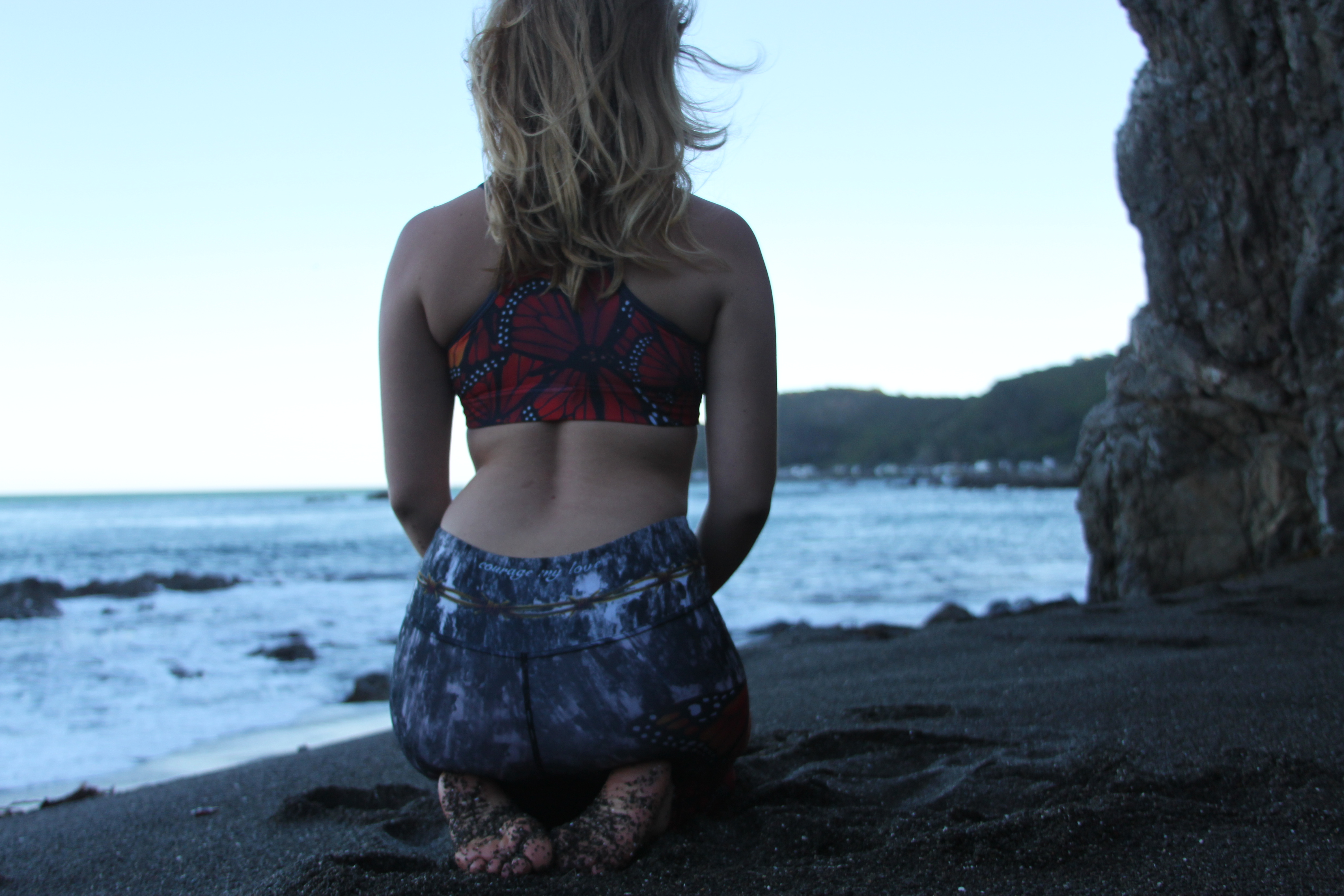
There’s a lot to learn on this journey of Yoga… Outfit by Courage My Love
by Lucinda Staniland
Most of us come to yoga with a whole lot of misconceptions about what yoga is. I was no different. Here are some of the mistakes that I made, and lessons that I learnt, as a new yoga student.
1. Asana does not equal yoga.
When I started doing yoga I was awed by the strength and grace of the physical practice I saw my fellow students doing. I couldn’t wait for the day when I too would move with such beauty. I fell in love with asana.
But asana (physical postures) is not Yoga. Asana is a tool of yoga.
What is Yoga? It is a state of self-realization, and it is also the practice that we do in order to experience this state. So physical postures are one part of the practice of Yoga, as are meditation, pranayama, kirtan, and the yamas and niyamas. These are all tools which helps us to observe the fluctuations of our minds, and to get a little closer to the state of self-realization.
It is possible to practice asana without practicing yoga. In fact, this has become extremely common. I know I’m not alone in having discovered yoga solely in the form of asana, as this seems to be the experience of most Western yoga practitioners. This results in many of us modern day ‘yogis’ missing out on the real treasures of a yoga practice, and settling instead for a limited asana practice, that can only ever take us part of the way to what we really crave.
2. A home yoga practice is essential. No excuses.
I was lucky to start my yoga journey with teachers who strongly encouraged their students to cultivate a home yoga practice. In fact, it was their main goal as teachers, and they regularly held sessions at the studio where they supported us to develop our personal yoga practice.
Why were my teachers so insistent on a home yoga practice? Well, a home yoga practice is what makes the difference between practicing yoga postures and actually practicing yoga. It’s the container that holds and supports your yoga, forcing you to show up daily on the mat, even when you are overwhelmed with resistance and excuses.
Sadly, many yoga teachers don’t place any emphasis on developing a home yoga practice, and may not even have one themselves. Perhaps it’s not seen as an economically advisable approach, but more likely it appears that many yoga teachers simply aren’t aware of the importance of a home yoga practice, having been taught by teachers who didn’t have one themselves.
Your home yoga practice doesn’t have to be long, complicated or even involve any asana. It could be as simple as ten minutes of meditation every morning. Or listening to a Yoga Nidra recording every night before bed.
3. You don’t need to be flexible to do yoga
A common misconception among new yogis is that flexibility is the true measure of success in a yogi. The further forward you can bend, the logic goes, the more advanced a yogi you must be. And so the new student at their first yoga class feels incredibly self conscious about their flexibility, or worse, they’re so intimidated that they won’t attempt yoga at all.
And yet the idea that you need to be flexible to do yoga is flat-out untrue. In fact, it’s ridiculous! Most of us come to yoga with bodies that we have neglected or harmed in some way, and all of us come to yoga with bodies that move in particular ways, bodies that have limitations and strengths.
Whatever you come to yoga with is OK. We all have to start where we are, and because our modern lifestyles sure as hell don’t make it easy for us to cultivate healthy relationships with our bodies, most of us have a lot of work to do. That is the work that we begin to do when we come to yoga. This is yoga.
Flexibility is a side benefit of yoga, it is not in any way a measure of the integrity or strength of one’s yoga practice. A deep backbend does not equal a ‘good’ yoga practice. Yes, over time a dedicated yoga does tend to open the body, allowing you to soften, and to increase your flexibility. But think of it as a perk of the practice, rather than a prerequisite or an end goal.
4. Injury is possible.
When I first began my yoga practice I had an unconscious belief that it was impossible to be injured doing something as virtuous and healthy as yoga. Plus I was in the midst of recovering from an eating disorder, and a subtle sense of aggression towards my body pervaded everything I did.
This was a dangerous combination of beliefs to enter a yoga studio with. It led to me doing a lot of advanced postures, particularly backbends, that I wasn’t ready for. I was naturally flexible, so I could almost always find a way to get myself into a given posture, but I didn’t have the strength or awareness required to do it with integrity.
What happened? I got injured, and for the first time in my life I experienced back pain. I continued to force my way into advanced backbends, but I felt a growing uneasiness. Perhaps, just perhaps, this virtuous and ‘safe’ activity wasn’t so good for me after all.
So yup, turns out that you can get injured in yoga. It doesn’t help that many of us – like me – come to yoga in a state of disconnect from our bodies, with a whole lot of unconscious beliefs about what yoga should be like. The solution? Discard magical thinking, pay attention, question your beliefs about yoga and your body, and ask for help from your teachers so that they can help you to do this.
5. Mainstream yoga images (often) suck.
I came to yoga just before that crazy explosion of social media that has changed so much about our lives. I had a blissfully old fashioned and unflashy view of the practice. For years, I associated yoga with serious, committed people who wore comfortable clothing made of natural fibres and attended to their yoga practice with quiet devotion.
The arrival of Facebook, Instagram and Twitter changed all that. Suddenly I was drowning under a deluge of ‘perfect’ yoga images, usually of young, white, slim and ‘perfect’ women, showing off their bodies in an advanced yoga pose.
I recognized that images didn’t represent me or my yoga practice. I felt manipulated by them, and yet I couldn’t look away. They were seductive, these images, and like it or not, they began to infiltrate my yoga practice with feeling of insecurity: Not slim enough, not strong enough, not sexy enough, not beautiful enough, not flexible enough…
Over time I’ve learned to limit my exposure to perfect yoga images, and to always always question how I respond to them. I’m not alone in feeling that too many perfect yoga images do yoga a dis-service. Real yogis know that perfection is not what yoga is about, and they’re forming a growing movement of rebellion against mainstream yoga images.
6. Yoga teachers will let you down.
Yoga teachers are not perfect beings. This is particularly true in the day and age of unregulated 200Hr Yoga Teacher Trainings, which have released countless enthusiastic but minimally experienced yoga teachers onto the unsuspecting public.
And guess what? Some of them are not very good yoga teachers – not yet. They may not know how to keep their students safe from injury, they might give dodgy dietary advice, develop inappropriate relationships with their students, give confusing and misleading cues, and just generally fail to transmit the true essence of yoga.
That’s not to say that here aren’t great yoga teachers out there. Still, even the best yoga teacher will let you down sometimes. No matter how awesome they may be, yoga teachers are still human, liable to make mistakes and to hurt people, as we all do sometimes. So keep your yoga teacher off any kind of pedestal and you’ll be all the better for it.
7. Yoga teachers will transform you.
On the flipside of that, a good yoga teacher can break your heart, body and mind wide open. They can help you access parts of yourself that you never imagined existed. They can catalyse serious and enduring transformations, and keep you safe throughout.
Sometimes you need the help of a yoga teacher to progress your practice. Cultivating your inner teacher and committing to a daily personal practice is the foundation of a yoga practice, but when you’re ready for it the direct transmission and skillful instruction that you receive from a real life interaction with a yoga teacher can supercharge your progress, and blow through your obstacles.
Good teachers are well-worth hunting down, and studying with.
8. Yoga will revolutionize your relationship with the everyday stuff of your life
I never imagined the extent to which yoga would affect every aspect of my life, no matter how mundane. When we cultivate awareness on the yoga mat it starts to spread out into all aspects of our lives. Whether we like it or not, the yogic mindset we are developing starts to illuminate our unconscious habits and beliefs.
We might start to pay attention to how regularly we reach for a glass of wine in the evening, and see that underneath that craving for alcohol lies a deep need for rest and stillness. We might get curious about our coffee habit, and how it affects our pranic body. We might notice how good we feel when we fuel our body with nourishing food, and become awake to the ways in which we abuse and harm our body through food.
Suddenly, even though you may have just started yoga for the physical practice, your entire life is changing.
9. Yoga will relentlessly bring up all your ‘stuff’ and gradually peel away the layers of your ego. If you let it.
I came to yoga looking for solace from emotional pain. But that’s not what yoga is about. While yoga has given me tools to work with pain, it has also relentlessly brought it up, again, and again, and again.
Yoga isn’t a get out of jail free pass, it doesn’t allow you to run away from the pain of your life. Yoga is self-realization, and self-realization is a messy and painful process. The more that we practice awareness, taking our yoga off the mat and into our lives, the more we are confronted with the deeply ingrained beliefs we hold about ourselves and the world, and the more we find that all of our old sorrows and the hurts come back for healing and release.
Yes, sometimes this process straight out sucks, but I’ve come to believe that the alternative – staying numb and disconnected – is never worth it. Commit to the process of yoga. Let it change you, and you won’t regret it, even on the most challenging of days.
10. There’s this thing called Kundalini and it could blow your life wide open.
Kundalini is the wild card of yoga. It has a dangerous, mystical ring to it, it’s rarely discussed in yoga classes, or in mainstream yoga circles, and most yogis couldn’t tell you what it is. Yet our Kundalini articles are consistently the most read on the entire website, and we get emails and questions all the time from people who experienced it.
A Kundalini awakening is when Shakti, a form of divine feminine energy that lies dormant at the base of our spine, literally wakes up and starts to move up the spine toward the crown of the head. It’s an experience of self-realization, but it can sometimes show up looking like mental illness, or a psychotic breakdown. Kundalini can be catalysed through dedicated yoga practice, but also through trauma, mis-use of drugs, illness, or in a dream.
The effects of Kundalini are serious and intense. It can blow your heart, mind and life wide open, and if you’re not ready for it you’ll have a hard time putting all the bits back together afterwards. It’s generally agreed that it’s dangerous to awaken Kundalini without the support of a Master, and for good reason.


Thank you for this article! I agree with what is said and had similar experience.
Keep your practice
Shanti
One of my favorite quotes, by Dr. Joe Dispenza, is that “mastery is when our internal chemical state is greater than anything in our external world.” Yoga is a fantastic tool that helps us do this, both through the practice of asana, meditation, and service.
And, you’re correct, this requires a 365-day practice, on and off of the mat.